Lachha Paratha | North Indian Laccha Paratha
Lachha paratha or Laccha Paratha is a popular variant of paratha from North Indian cuisine. These are whole wheat flatbreads made with a simple unleavened dough consisting of basic ingredients like whole wheat flour, salt and ghee or oil. The specialty and uniqueness of this paratha are the various visible flaky and crispy layers that are also soft and tender. Making these traditional Indian layered flatbreads is easy and great to mop up with any curry or gravy dish.
About Lachha Paratha
This flaky crispy paratha variant is also called as Lachedar paratha or Paratwala paratha. In Punjabi language “Parat” or “Lachha” means layer and layers can be seen on the paratha when it gets cooked.
The South Indian variation of this laccha paratha is Parotta which is made from all-purpose flour and is a specialty of Malabar cuisine from the South Indian state of Kerala.
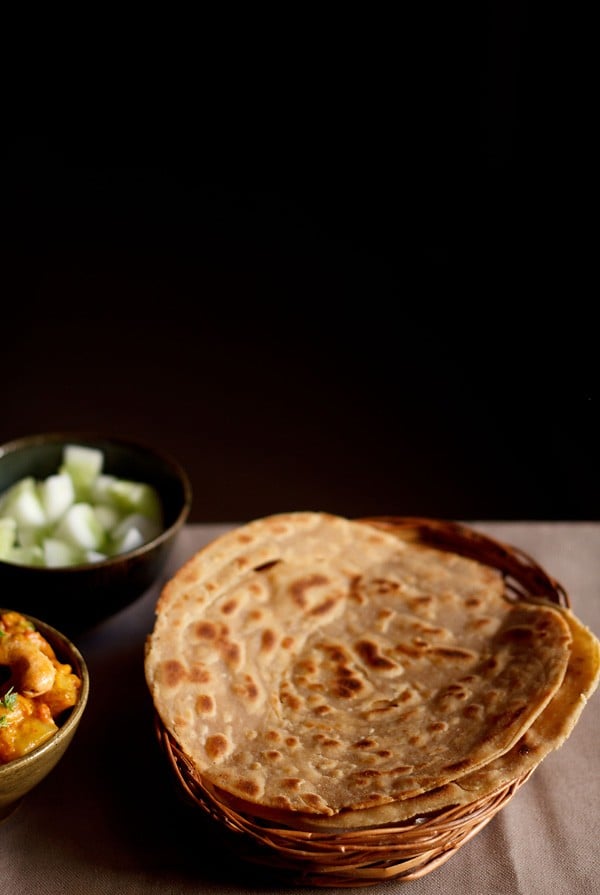
The Malabar parotta is more softer than laccha paratha due to the all-purpose flour. Lachha Paratha is usually made with whole wheat flour.
Although you can include some all-purpose flour in the dough. In some restaurants, they use a mix of both these flours. But while making at home I recommend using whole wheat flour.
Lachha paratha is an easy paratha to make. To get these layers the dough is folded and pleated many times. There are some techniques to get the multiple layers. I am sharing the method which I use often.
I make the laccha parathas using this technique that I have shown in the stepwise photos. This method works for me greatly and I find it simple and easy. I use the same technique to make the Pudina Paratha (layered flatbread flavored with mint and spices).
I usually roll the paratha to medium thickness. But if you make them more thick then more layers will be visible but then you have to cook the paratha really very well so that it is not left uncooked from inside.
Sometimes the paratha served in restaurants is so thick that it has many layers but uncooked from inside. You can actually taste the uncooked dough. Ensure that the paratha are roasted really well and do not roll them very thick.
Serve the laccha paratha hot with any vegetable curry like Aloo Matar, veg kadai, veg handi or with paneer curry recipes like Paneer Butter Masala, matar paneer, Kadai Mushroom, paneer makhani or with Mango Pickle.
Don’t serve them cold. They have to be eaten when they are hot or warm for the best taste and texture.
How to make Lachha Paratha
Form Dough
1: in a bowl or vessel take 2 cups whole wheat flour along with salt as per taste.

2. Add 1 to 2 teaspoons of ghee or oil.
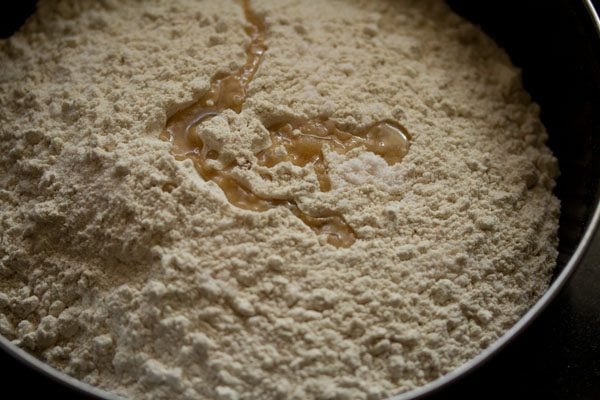
3. Next add water as required in parts.

4. Knead the whole wheat flour with water to a smooth dough. Cover the bowl with a lid and keep aside to rest for 20 to 30 minutes.
You can also use a stand mixer to knead the dough.

5. After the dough has rested, make medium-sized balls from the dough. Cover the bowl or the pan with a napkin or lid.

Make Laccha Paratha
6. Take one dough ball on a rolling board. Lightly dust it with some flour on both the sides.

7. Roll it into 8 to 8.5 inches diameter thin disc. Sprinkle flour while rolling.

8. Apply ghee or oil liberally on the paratha disc.
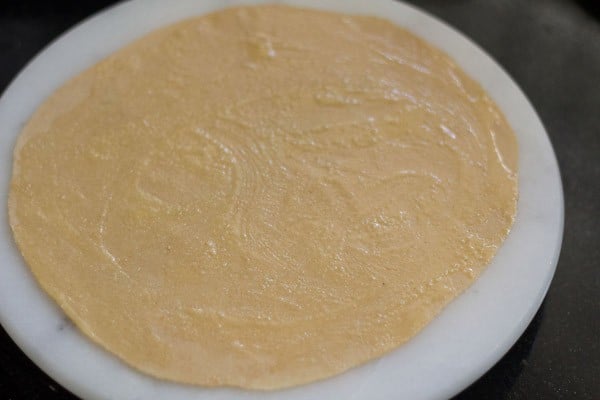
9. Sprinkle some whole wheat flour on top.

10. From the edge start folding and pleating the rolled dough as shown in the photo below.

11. Keep on pleating it like shown in picture below or you can also fold it like a paper fan. Do this till you come to the end.

12. Roll the pleated dough in a tight cirlce. Join the edges.

13. Dust some flour and now start rolling again to a diameter of about 7 inches.
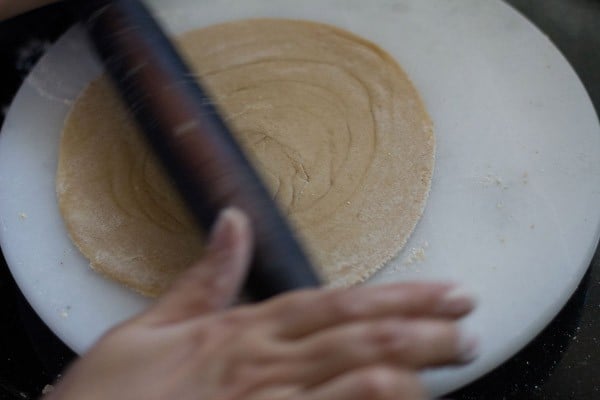
14. Rolled laccha paratha is ready to be put on tawa or griddle.

Roast Laccha Paratha
15. Heat the tawa or griddle or frying pan. Keep the flame to medium-high to high. When the tawa becomes hot then place the paratha on it.
Tip: To check the hotness of the pan, sprinkle 2 to 3 pinches of flour on it. If the flour particles get browned in a few seconds then the pan is hot enough for the paratha to be roasted.
Wipe up the browned flour particles with a kitchen napkin before keeping the paratha on the pan.
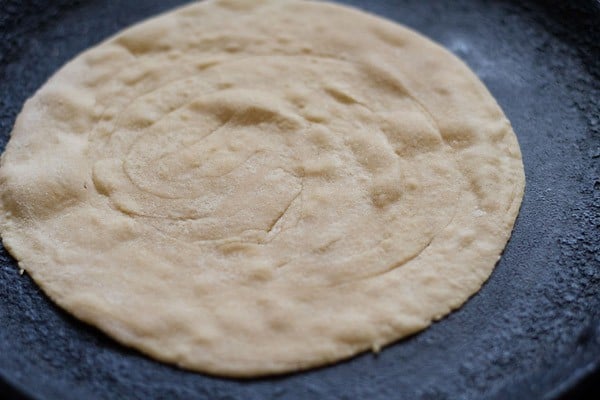
16. Turn the paratha when one side is partly cooked. You will see some air pockets and a few blisters.
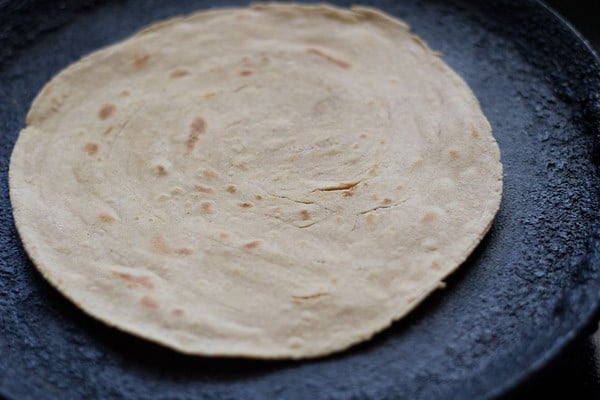
17. Apply ghee or oil on this side. Wait for the second side to cook.

18. Then flip again after the second side is cooked and spread ghee or oil on this side and cook it for some seconds.
Flip again for a couple of times, till the lachha parathas are browned evenly and well cooked. Press the sides with the spatula while frying the parathas. Alternatively, you could also add some ghee on the pan and then roast them.
Make all laccha paratha this way. If not serving them immediately then stack them in a roti box or casserole and keep them tightly covered. But eat them while they are still warm.
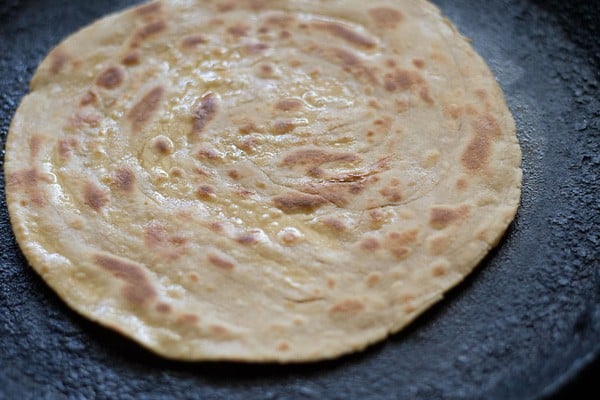
Serve Lachha paratha hot with any curry recipe like Palak Paneer, Kadai Paneer, kadai mushroom, Chana Masala, Veg Korma, Vegetable Curry or with mango pickle.
You can also squish the paratha in your palms (take care as they will be hot) so that the layers are visible and then serve.
Some people prefer to have plain paratha or this laccha paratha with their morning breakfast. I enjoy paratha with my morning cup of hot chai or sometimes with a side vegetable dish or pickle.

More paratha recipes
Step by Step Photo Guide Above
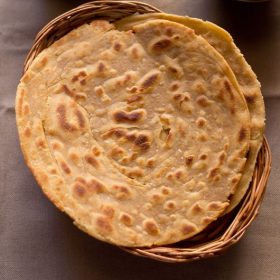
Ingredients
Instructions
Kneading paratha dough
- In a bowl or vessel take 2 cups whole wheat flour along with salt as per taste.
- Add 1 to 2 teaspoons of ghee or oil. Next add water as required in parts.
- Knead the whole wheat flour with water to a smooth dough. Cover the bowl with a lid and keep aside to rest for 20 to 30 minutes.
- Later make medium sized balls from the dough. Cover the bowl or the pan with a napkin or lid.
Rolling lachha paratha
- Take a dough ball. Roll it into 8 to 8.5 inches diameter thin disc on a dusted rolling board.
- Apply ghee or oil liberally on the paratha disc. Sprinkle some flour on the top.
- From the edges start to fold and pleat the paratha till the end.
- Roll the pleated edges tightly. Join the edges.
- Lightly dust with flour and now roll into round parathas of about 7 inches in diameter.
Roasting lachha paratha on griddle
- Heat the tava or griddle or frying pan. The tava should be hot. Place the paratha on the tava. Keep the flame to medium-high or high.
- Turn the paratha when one side is partly cooked. Apply ghee on this side. Cook for a minute.
- Now turn again and apply ghee on the other side.
- Flip again for a couple of times, till the parathas are browned evenly and well cooked. Press the sides with the spatula while frying the parathas. As sometimes the edges are not cooked well. So I always press the edges of paratha with a spatula.
- Alternatively, you could also add some ghee on the tava and then pan fry the paratha.
- Serve the lachha paratha hot with any Indian dal or a vegetable curry of your choice.
- Some recipes that will taste very good with these parathas are dal makhani, chana masala, rajma masala, palak paneer, veg kurma, veg kadai, matar paneer, aloo matar etc.
- For best taste have these parathas hot. They can also be had with a cup of hot tea or can be had with mango pickle or lemon pickle.
Notes
- Knead the dough very well for about 8 to 10 minutes. It should be soft, pliable and smooth.
- If you want a slightly soft texture then add some all purpose flour. E.g. You can use equal proportions of whole wheat flour and all purpose flour or any ratio of your choice.
- For the best taste and texture, these flatbreads have to be served hot or warm. Once they cool and if you reheat them then they become chewy and dense.
- Remember to roast the paratha on a moderately hot pan. If the pan is not hot enough the paratha will become hard. On a very hot pan, the outer layer may get burnt faster leaving the inside dough undercooked.
- For a vegan laccha paratha use any neutral flavored oil instead of ghee.
- The recipe can be doubled or tripled.
- Note that the approximate nutrition info is for one paratha made with 1 tablespoon of ghee (includes both rolling and roasting).
Nutrition
Lachha Paratha recipe from the blog archives first published on June 2010.

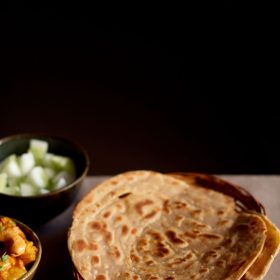
This is a really good lachha paratha recipe. I’ve really become a pro in making it now.
That’s great to hear! I am glad the recipe helped you — and even better that you’ve mastered it now. Thank you for the lovely feedback.
I always thought making these parathas was difficult especially those layers.but with the detailed instructions and pics it was quite easy.tried it today and it came out quite well with the layers distinctly visible.
thanks winnie for the rating and the review. the layers in lachha paratha can be made in 2 to 3 ways. personally i find this one easy and a second method – where the rolled chapati is given a cut till the center. then with one of the cut edges, it is rolled tightly going clockwise or anti-clockwise. then the collected roll is pressed from the top and flattened. then again rolled with the rolling pin to get the layered paratha. thanks again.
Dear: May all the blessings come your way. I and my wife just had our first baby, and she has been so busy. I tried your recipe and made her a few parthas and the breakfast. She loved it and could not believe that I did it on my own..
Stay blessed – love from Pakistan!
Aamir Khan
Thanks Aamir for your best wishes and kind words. Nice to see you taking care of your wife. Love from India.
Hello Amit. I love to cook as my husband n son both love to eat varieties n ur recipes are so easy to cook n good to taste that i dont have to think a lot… i just select one and present them.. the first bite they say mmmmmm and i thank u… thanks a lot for being with me in such a way… love u…
thanks a lot ritu. glad to ready your sweet comment and feedback on the recipe. stay blessed and happy cooking ????
I made it for dinner last night. Turned out good. I want to know that in step 5 do we apply ghee/oil on the top or on both sides? When rolling it in a circle the outer edge wouldn’t stick. What did I do wrong?
ayesha, ghee or oil is only applied on one side on the top. you have to press the edges lightly, so that they stick. if you use a lot of flour while rolling, then the outer edges won’t stick. so knead the dough in such a way, that it is soft but not sticky. if sticky dough is used, then a lot of flour is required while rolling the dough.
I used to make lachha paratha with a different method but with that method layers would not show up distinctly. I tried it your way and and it was a big hit! Not only were there perfect visible layers on the parathas but also they were crispier.. This is a very tasty way of making parathas. Thank you
thank you ruchi. there are a few different ways to make lachcha paratha. even i have tried them. i prefer this method as the layers get visible after roasting the parathas. and as you mention there is crispness in the parathas also.
thankyou sir for laccha parata recipe it is very nice and i made step by step as shown in the pictures. if i have any dought i will just brows all of your recipes quickly i get the hints thankyou sir.
thanks khurshidanzar 🙂
I always wanted to make lachha paranthas, but was never able to mk them reading other’s recipes…. U hv explained it so well that i was successful this time…. Thank you so much.
welcome always sheerupa 🙂 thankyou for your positive feedback.
Hi
I have tried your broccoli parantha and my husband loved it..today i am going to try lachha parantha…i just love your website it has helped me a lot..
Thanks
Preeti
welcome preeti. glad to know this. but i have not posted broccoli paratha yet. but will post it soon.
Hi dassana..I get very little time to cook n am not so good at it…but my husband is a foodie…can kill for a good dish…whatever li’l time I have..I just check out your website n cook for him.believe u me…he loved each dish I made…thanks to u…am a huge….big…great fan of yours….thank u so much….
welcome dr. preeti. glad to know that blog is helping you in cooking.
Hi dassana, I tried laccha parrata and came out so good except for the shape. 😉 Guess for the proper shape it needs a lot more practice. When I used to go to north Indian dhaba I used to wonder how they make laccha parrata. Seeing your recipe I felt like a cake walk. Thanks for the reciepe 🙂
welcome kaavya. yes, it needs practice to make lachha paratha. but home cooked food is better even if u don’t get the perfect shape in parathas.
Hi I have tried your whole wheat pita recipe and it’s awesome.
thanks mala.
easy and quick reciepi
really great and easy I have tried and it became so easy to make
thanks nazia
very easy to make .the description is so wonderful and artful and it has made it easy to follow.